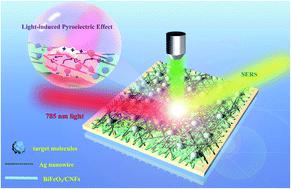当前位置:
X-MOL 学术
›
J. Mater. Chem. A
›
论文详情
Our official English website, www.x-mol.net, welcomes your feedback! (Note: you will need to create a separate account there.)
Synergistic SERS enhancement and in situ monitoring of photocatalytic reactions in a plasmonic metal/ferroelectric hybrid system by the light-induced pyroelectric effect
Journal of Materials Chemistry A ( IF 11.9 ) Pub Date : 2022-06-14 , DOI: 10.1039/d2ta02678c Daotong You , Ru Wang , Jiwei Xie , Lei Liu , Kaiwei Li , Xile Han , Tuan Guo , Chunxiang Xu
Journal of Materials Chemistry A ( IF 11.9 ) Pub Date : 2022-06-14 , DOI: 10.1039/d2ta02678c Daotong You , Ru Wang , Jiwei Xie , Lei Liu , Kaiwei Li , Xile Han , Tuan Guo , Chunxiang Xu

|
The pyroelectric effect converts thermal energy into usable electrical energy. It is an ideal and effective strategy to enhance the surface-enhanced Raman scattering (SERS) detection sensitivity by tuning the electromagnetic fields. In this work, a plasmonic metal/ferroelectric hybrid SERS substrate was fabricated by integrating a pyroelectric functional layer composed of BiFeO3 with an electron/heat conduction layer of carbon nanofibers (CNFs) using the electrospinning technique. The initial layer was followed by a plasmonic layer of Ag nanowires, which were uniformly spin-coated on BiFeO3/CNFs. By introducing periodically switched near-infrared (NIR) light, the BiFeO3/CNFs could effectively convert the thermal energy induced by light into pyroelectric charge, which could adjust the electron densities of Ag, and in turn boost the electromagnetic fields at the “hot spots”. The hybrid Ag–BiFeO3/CNFs were used to test the Raman signals of methylene blue (MB), and a 5.6-fold enhancement of the SERS signal was achieved compared with that noted without the pyroelectric effect and the following parameters were obtained: an ultra-low detection of 10−13 M, a high enhancement factor of 8.3 × 109, and excellent reproducibility with an RSD of 4.08%. The theoretical calculations revealed that the excellent sensitivity was mainly ascribed to the synergistic light-induced pyroelectric and plasmon effects. In addition, this substrate was also used for the detection of ciprofloxacin (CIP) in milk with a limit of detection as low as 10−10 M. Furthermore, the Ag–BiFeO3/CNFs were used to successfully in situ monitor the photocatalytic reduction of p-nitrophenol (p-NTP) to 4,4′-dimercaptoazobenzene (DMAB) by SERS in real time. This work provides an efficient strategy to develop highly sensitive SERS substrates through pyroelectric-plasmonic hybrid structures, and opens a new avenue for the development of energy harvesters that can be used for extensive applications.
中文翻译:

通过光致热释电效应在等离子体金属/铁电混合系统中协同增强 SERS 和原位监测光催化反应
热释电效应将热能转化为可用电能。通过调节电磁场来提高表面增强拉曼散射(SERS)检测灵敏度是一种理想且有效的策略。在这项工作中,通过使用静电纺丝技术将由 BiFeO 3组成的热释电功能层与碳纳米纤维 (CNF) 的电子/热传导层集成,制造了等离子体金属/铁电混合 SERS 基板。初始层之后是Ag纳米线的等离子体层,其均匀地旋涂在BiFeO 3 /CNFs上。通过引入周期性切换的近红外 (NIR) 光,BiFeO 3/CNFs可以有效地将光诱导的热能转化为热电荷,从而调节Ag的电子密度,进而增强“热点”处的电磁场。混合Ag-BiFeO 3 /CNFs用于测试亚甲蓝(MB)的拉曼信号,与没有热释电效应的情况相比,SERS信号增强了5.6倍,并获得了以下参数: 10 -13 M的超低检测,8.3 × 10 9的高增强因子,以及出色的重现性,RSD 为 4.08%。理论计算表明,优异的灵敏度主要归因于协同光致热释电和等离子体效应。此外,该底物还用于检测牛奶中的环丙沙星(CIP),检测限低至 10 -10 M。此外,Ag-BiFeO 3 /CNFs 用于成功地原位监测光催化还原对硝基苯酚( p-NTP) 通过 SERS 实时生成 4,4'-二巯基偶氮苯 (DMAB)。这项工作提供了一种通过热释电-等离子体混合结构开发高灵敏度 SERS 基板的有效策略,并为开发可广泛应用的能量收集器开辟了一条新途径。
更新日期:2022-06-14
中文翻译:

通过光致热释电效应在等离子体金属/铁电混合系统中协同增强 SERS 和原位监测光催化反应
热释电效应将热能转化为可用电能。通过调节电磁场来提高表面增强拉曼散射(SERS)检测灵敏度是一种理想且有效的策略。在这项工作中,通过使用静电纺丝技术将由 BiFeO 3组成的热释电功能层与碳纳米纤维 (CNF) 的电子/热传导层集成,制造了等离子体金属/铁电混合 SERS 基板。初始层之后是Ag纳米线的等离子体层,其均匀地旋涂在BiFeO 3 /CNFs上。通过引入周期性切换的近红外 (NIR) 光,BiFeO 3/CNFs可以有效地将光诱导的热能转化为热电荷,从而调节Ag的电子密度,进而增强“热点”处的电磁场。混合Ag-BiFeO 3 /CNFs用于测试亚甲蓝(MB)的拉曼信号,与没有热释电效应的情况相比,SERS信号增强了5.6倍,并获得了以下参数: 10 -13 M的超低检测,8.3 × 10 9的高增强因子,以及出色的重现性,RSD 为 4.08%。理论计算表明,优异的灵敏度主要归因于协同光致热释电和等离子体效应。此外,该底物还用于检测牛奶中的环丙沙星(CIP),检测限低至 10 -10 M。此外,Ag-BiFeO 3 /CNFs 用于成功地原位监测光催化还原对硝基苯酚( p-NTP) 通过 SERS 实时生成 4,4'-二巯基偶氮苯 (DMAB)。这项工作提供了一种通过热释电-等离子体混合结构开发高灵敏度 SERS 基板的有效策略,并为开发可广泛应用的能量收集器开辟了一条新途径。

























 京公网安备 11010802027423号
京公网安备 11010802027423号